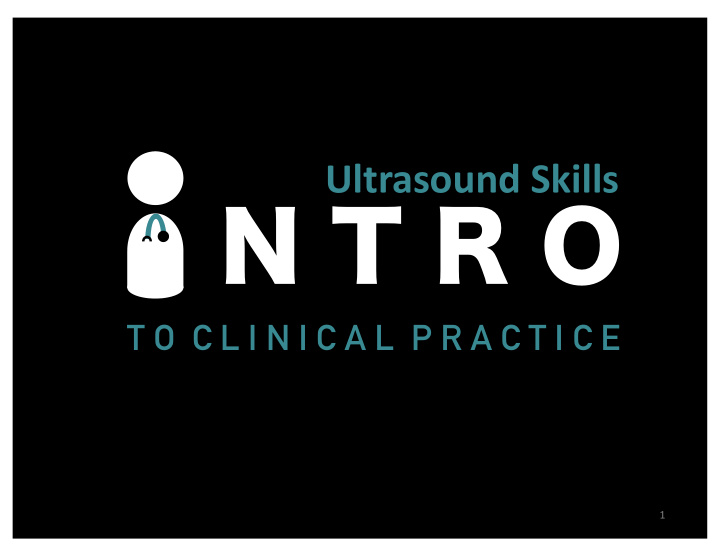



N T R O Ultrasound Skills T O C L I N I C A L P R A C T I C E 1
Welcome + Overview 2
U/S Curriculum ICP Foundations JVP Pneumothorax Course 8 FAST Lung U/S POCUS (Point Of Care UltraSound) Image acquisition Image interpretation Clinical application 3
Foundations 4
How does U/S generate images? 5
6
7
8
Define penetration, attenuation, and reflection (wave properties). 9
10 Image Source: EDE1 Book
Attenuation 11
SKIN TISSUE Reflection 12
How do different tissue densities (e.g. fluid, solid organ, bone, air) appear on U/S, and why? 13
Fluid 14
Solid Organ 15
Bone (Spine) 16
Air 17 Image Source: http://www.startradiology.com/internships/general-surgery/abdomen/ultrasound-abdomen-general/
What is an acoustic window? 18
LIVER HEART 19
What are shadowing and enhancement artifacts? 20
Shadowing 21
Enhancement 22
Define hyperechoic, hypoechoic, and anechoic. 23
Hyperechoic (diaphragm) Hypoechoic (renal cortex) 24
Anechoic 25
What is depth and gain? 26
Object of interest
Too Shallow = entire object of interest not in screen Too Deep = wasted screen space 28
Gain Undergained: Overgained: Tissue inappropriately appears anechoic Fluid has internal echoes 29
What are common probe types and its uses? 30
Linear Curvilinear Phased Array 5-10 MHz 2-5 MHz 1-5 MHz
Procedures Abdomen Abdomen Vessels Lung Lung Pleura IVC IVC Skin Heart MSK
What is frequency, and how does this relate to penetration and resolution? 33
Taken from Soni, et al. Point of Care Ultrasound 2015. Elsevier. 34
What is B mode and M mode? 35
B Mode M Mode 36
Foundations Walk-Through 37
JVP Demo and Practice 38
SCM IJ Carotid Thyroid 39
Clinical Application Use ultrasound JVP the same as visual JVP: to estimate CVP Deol et al CHEST 2011;139;95-100
PTX Demo and Practice 42
Exam Technique RIB PLEURA AIR ARTIFACT Must identify pleura in the ribspace
Pneumothorax 1. No lung sliding 2. A lines in absence of B lines 3. Lung Point
Sliding Pleura: Normal 45
Seashore: Normal SEA SHORE 46
Bar Code: Pneumothorax 47
B-Lines: No pneumothorax 48
A-Lines: Normal Pleura (or pneumothorax) 49
Lung Point: Pneumothorax Infant with respiratory distress syndrome. B-lines present on one side. Transition to an area (pneumothorax) where A-lines (horizontal lines) are present without B-lines (comet tails). The transition point is the LUNG POINT. 50 Image Source: https://www.researchgate.net/figure/Static-image-of-lung-point-arrow-in-an-infant-suffering-from-RDS-Note-the-coalescent-B_fig1_301830426
Interpretation Summary Pneumothorax excluded: lung-sliding, seashore sign, B-line (lung rocket) Pneumothorax possible: lung-sliding absence & barcode sign Other causes of no lung-sliding: COPD/asthma attack (stiff lungs) Effusions Consolidations Adhesions Chest tubes Pleurodesis Subcutaneous emphysema Pneumothorax present: lung-point 51
Ultrasound Machine Care 52
Ultrasound Machine Care Never drop transducers Never roll over cords Keep machine plugged in after use Clean after use with appropriate wipes Use least energy possible (avoid Doppler, minimize scan time, turn off after use) 53
Relay Race 54
1. Seashore Sign 2. Two anechoic structures near each other 3. Two hyperechoic structures near each other 4. Hepatorenal interface 5. IJ Taper (Longitudinal View) 55
Questions? 56
YOUR FEEDBACK IS IMPORTANT ! Feedback helps improve This session Your facilitators The MED SCHOOL EXPERIENCE Workshop Credits - Workshop by Anthony Seto - Objectives and design contributions by Irene Ma - Workshop lesson plan reviewed by Ryan Lenz, Irene Ma, and Rob Warren 57 - Picture contributions from Ryan Lenz
Recommend
More recommend